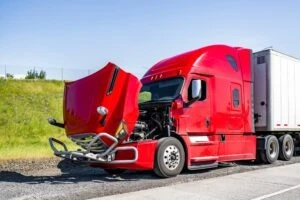
Our truck accident lawyers in Indianapolis have over 100 years of experience advocating for Hoosiers in need of legal support. If you need help holding truck drivers, trucking agencies, or other parties responsible for a recent collision, you can ask our team for legal guidance.
Our lawyers encourage you to use this dictionary of trucking terms to better understand your accident as well as your means of legal recourse.
A
Anti-Lock Braking System – A truck’s anti-lock braking system, or ABS, uses the controlled release of pressure to prevent trucks from hydroplaning or otherwise losing control of their brakes.
Air Ride Suspension – Air ride suspension ensures that fragile freights benefit from a smoother ride thanks to the aid of compressed air and/or airbags.
Audit – The Department of Transportation requires all motor carriers to undergo audits or examinations of their safety records to ensure compliance with the Federal Motor Carrier Safety Regulations. Failure to schedule or meet expectations during regular audits can result in a carrier being denied the right to continue operating freight on national interstates.
Authorized Carrier – Carriers and brokers can pre-approve carriers, establishing them as authorized carriers, before allowing them to transport freight.
Axel Rating – An axle rating determines how much weight a carrier can haul. Different groups of axles have different axle ratings.
Your Case Will Get
The Attention It Deserves

B
Backhaul – Backhauling allows a driver to deliver freight to a final location near the driver’s home or primary terminal, benefiting the driver in their effort to get home.
Base Plate – Trucks must have license plates that reflect the state in which they’re registered. That plate is known as the truck’s base plate.
Bill of Lading – Bills of lading outline the economic agreement established by shippers and their carriers before a delivery run. These bills include information about the goods the driver will transport, the freight’s weight, and ideal delivery dates. Bills of lading are not valid until all parties involved in the transportation process sign them.
Binder – Truck drivers have an obligation to maintain an insurance binder with proof of short-term coverage, pending coverage, or other forms of protection. Drivers can update their binders as they finalize their policies.
Blindsiding – When a driver backs into a loading dock, it’s possible to lose track of a truck’s trailer, resulting in blindsiding.
Bridge Formula – Agencies like the Department of Transportation and state-based institutions rely on bridge formulas, or mathematical equations, to determine how much weight statewide bridges can hold, how trucks can better distribute their weight, and what trucks need to avoid what bridges.
Broker – Brokers, or brokerages, work as go-betweens, facilitating relationships between shippers and carriers. Drivers can rely on brokers to help them set transportation rates, preferred routes, preferred forms of transportation, and other contract details.
Bulk Freight – Bulk freighters specialize in carrying uncontained materials, including liquids and solids. Bulk freighters transport these goods en masse.
Burden of proof – Indiana’s burden of proof requires truck accident victims to gather enough evidence of negligence to argue that a driver, company, or affiliate caused their crash. Parties interested in recovering damages after a truck accident can use a wide array of evidence to meet the state’s burden and move their cases forward, including black box data, electronic data, shipment records, and witness statements.
C
Cab Card – All truck drivers have an obligation to maintain a cab card in their cab or the front of their truck, which provides police officers and any other parties with evidence of the vehicle’s registration. Trucks must have a registration for every state they pass through.
Cargo – Cargo is a broad term for the goods that a truck transports from one destination to another. It’s interchangeable with “freight.”
Cargo Insurance – Truck drivers and their agencies have an obligation to invest in insurance that may cover the cost of damaged goods should a driver get into an accident or endanger their freight.
Cargo Manifest – A truck’s cargo manifest details what items a driver is transporting and their destination.
Carrier – Trucking agencies or companies may also be referred to as carriers for hire. Carriers may own their own trucks or rent them from a third party.
Carrier Liability – Each carrier has an obligation to invest in insurance designed to protect it and its affiliates from the cost of damage to freight or fees resulting from delayed shipments.
Cartage Company – Cartage companies manage delivery and pickup services on a local scale.
CAT Scales – Truck drivers have an obligation to weigh their vehicles to ensure they’re within the legal boundaries established by the states they pass through. CAT scales are private scales not owned by the state that drivers can use to manage their freight.
Citizens Band Radio – Also known as CB Radio, Citizens Band Radio is a two-way system that drivers can use to connect with emergency responders and one another.
Certificate of Insurance – Insurance providers have an obligation to provide truck drivers with formal proof that the driver or company has invested in coverage that meets or exceeds minimum coverage requirements.
Chocks – Chocks are part of a truck’s maintenance gear. Drivers can place them in front and behind a truck’s wheels to prevent it from moving on unstable grades.
Civil Claims – A civil claim allows a truck accident victim to argue that parties involved in their truck accident negligently and recklessly endangered them. So long as a victim files their civil claim before their state’s statute of limitations expires, that claim should allow them to argue for compensation based on the losses sustained in their collision.
Class One Motor Carrier – A Class One Motor Carrier is a trucking agency that generates over $10 million in revenue annually.
Class Two Motor Carrier – A Class Two Motor Carrier is a trucking agency that generates between $3 million and $10 million in revenue annually.
Class Three Motor Carrier – A Class Three Motor Carrier is a trucking agency that makes less than $3 million per year.
Combination Gross Vehicle Weight – A truck’s combination gross vehicle weight accounts for the weight of the trailer, fuel, power unit, and freight, allowing applicable parties to calculate a vehicle’s total weight while it’s on the road.
Commercial Carrier – Commercial carriers allow clients to hire employed drivers to transport goods across the country.
Commercial Driver’s License – Anyone operating a truck, be they independent or part of a larger organization, needs to invest in a Commercial Driver’s License, or CDL, to operate a motor vehicle over 26,000 pounds safely.
Compliance Review – The Federal Motor Carrier Safety Administration requires all commercial parties to undergo a compliance review to ensure that drivers and their affiliates are operating within the safe operational standards set on local, state, and federal levels.
Consignee – Consignees receive shipments.
Consignor – Consignors send shipments.
Consolidation – Trucks delivering multiple incomplete shipments to the same destination may combine their loads to create a full truckload.
Contract Carrier – Contract carriers work on contracts with clients, including shippers, instead of serving as full employees.
Coupling – The process of coupling allows drivers to hook multiple trailers together.


D
DAC Report – A DAC report operates much like a driver background check. Carriers interested in working with certain drivers may request a DAC report to better understand that driver’s roadway experience, truck driving school certificates, access to essential equipment, and recent drug or alcohol tests.
Daily Log – A document filled out discussing a driver’s working day, going into detail about hours spent off-duty, on-duty, driving, and at sleeper berth. While some of these documents are handwritten, most carriers have transitioned to digital versions.
Damages – The term damages describes the compensation a truck accident victim stands to recover when filing an insurance or personal injury claim. The damages a victim recovers may cover the cost of their economic and non-economic expenses, so long as the victim uses evidence to tie their losses back to truck accident negligence.
Declared Value – The party shipping freight from one location to the other should declare the value of that freight prior to its transportation.
Detention – Carriers can charge drivers and their affiliates with detentions if carriers believe that those parties misused or overused their equipment.
Dispatcher – Dispatchers serve as middlemen between drivers and shippers, ensuring drivers can get to their final destinations without running into undue traffic or other obstacles. Dispatchers can also coordinate load transfers between parties.
Dock – Trucks park at docks to unload and load their freights.
Dock Plate – Dock plates prevent freight from falling into dock cracks, ensuring all goods get to their final destination with as few bumps in the road as possible.
Drive Line – A drive line ensures that the power generated by a truck’s engine reaches the wheels, propelling the truck forward.
Dry Box – Dry boxes haul goods that do not need climate control to make it from Point A to Point B safely.
Dunnage – Dunnage describes the materials a driver and packing crew may use to prevent a half-load or loose freight from shifting during transit.

E
Electronic Data Interchange – Also known as EDI, electronic data interchange ensures that the computers involved in the shipping process can communicate with one another and share documents addressing freight.
Electronic Logging Device – Beginning in 2019, the United States requires all truck drivers to maintain an electronic logging device, also known as a black box, in their trucks. Electronic logging devices record a truck’s mileage, speed, drive time, and other behaviors.
Endorsement – Truck drivers can pursue endorsements to receive permission to drive specialized vehicles or transport high-risk substances.
Escort – Sometimes, trucks transporting a high density of goods or goods that don’t easily fit onto a trailer may request an escort or a vehicle to assist them with the hauling process. Escorts have the right to stop traffic and specifically work to make sure there’s enough room on a road to accommodate an oversized load.
Excess Value – If a truck carries more value in a shipment than its insurance covers, it may be in possession of excess value.
Excise Tax – Certain products, including gasoline and diesel, cost extra to ship across the nation and are subject to an excise tax or additional fees.
Expediting – Clients who want to streamline a shipment can request that it be “expedited” or addressed by a dedicated team of drivers.
F
Federal Highway Administration – The Federal Highway Administration, or FHWA, manages construction on national highways and other features, including bridges and tunnels. This administration dictates decreases in speed and warns national truck drivers about obstacles or other risks to avoid while operating large vehicles in dangerous areas.
Federal Motor Carrier Safety Administration – The Federal Motor Carrier Safety Administration, or FMCSA, is a subdivision within the Department of Transportation. The administration strives to prevent truck accidents involving pedestrians, private motorists, and other trucks. Truck drivers and their affiliates can refer to the FMCSA for updates on safety regulations and technologies to use in their vehicles.
Freight Bill – Freight bills are also referred to as freight invoices, which reflect the value of a final transport bill. Freight bills can also detail additional expenses, including additional service charges.
Freight Class – The National Motor Freight Traffic Association breaks trucks down into different categories, or freight classes, based on the value of their freight and size. A truck’s freight class can impact the cost of shipping goods in that particular vehicle.
Freight Forwarder – Forwarders and brokers play similar roles. Where a broker manages relationships between recipients, senders, and drivers, forwarders manage relationships on an international scale.
Full Truckload – A full truckload describes a trailer that is completely full either at the beginning or end of a trip, thanks to consolidation efforts.
G
Grade – Grade is synonymous with slope and describes elevation changes along roadways. Truck drivers must account for grade to safely navigate larger loads across state lines.
Grandfather Clause – Grandfather clauses allow parties benefiting from older rules or regulations to refer to those older regulations instead of updated legislation.
Gross Combination Weight – A gross combined weight represents the most a tractor and trailer may weigh while navigating national roads.
Gross Vehicle Weight – A vehicle’s gross vehicle weight represents its highest acceptable unloaded weight, as stated by its manufacturer. A vehicle’s gross vehicle weight should account for all of its parts.
H
Hazardous Materials – Hazardous materials must be transported from Point A to Point B in designated vehicles. Drivers interested in transporting hazardous materials must obtain a hazmat endorsement. Common hazardous materials appearing in shipping manifests include diesel fuel, chlorine, and some fertilizers.
Head-On Collisions – A head-on collision is a truck accident in which a truck collides with another vehicle’s front fender. Head-on collisions tend to occur when one vehicle slips into the wrong lane or when a driver loses control behind the wheel. Given the disparity between a truck’s size, weight, and speed and that of a private vehicle, these accidents can prove deadly.
Headache Rack – Headache racks prevent the freight on the rear end of a truck’s trailer from coming into dangerous contact with the truck’s cab while a driver is on the road.
Header Board – Like a headache rack, header racks prevent the freight on the front end of a truck’s trailer from sliding into the cab.
Heavy Hauler—A specific type of truck that can haul oversized loads or freight with a higher-than-average weight. Most drivers are required to secure a specific license or permit to operate a heavy hauler.
Highway Use Tax – Commercial drivers are required to pay the IRS a highway use tax to legally operate vehicles with a gross weight of 55,000 pounds or more.
Hopper Body—A type of truck that primarily transports food goods, including grain, or other loose freight, like sand.
Hot Load – A slang term that describes freight that needs to reach its destination on an expedited schedule.
Hours of Service—Truck drivers have the right to break for food and sleep. The FMCSA sets hours of service that drivers may not exceed while working on a contract or with a company. If a company tries to push a driver to work outside their hours of service, the driver may have the right to sue that company for damages.
I
Icing Charge – If truck drivers have to navigate unsafe roads during snow or ice storms, they may have the right to impose an icing charge when submitting their final bill, especially if they’re delivering time-sensitive freight.
In Bond – Shipments that are still undergoing processing customs are referred to as in bond.
Insurance Claims Adjuster – Insurance claims adjusters work as agents of insurance companies to meet with truck accident victims after collisions. Most insurance claims adjusters serve as a survivor’s primary point of contact with an insurance company.
Interchange Agreement – Two companies interested in exchanging a trailer between shipments may enter into an interchange agreement.
Intermodal Transportation – If a shipment needs to move from a truck to a ship or truck to a train (or vice versa), it benefits from intermodal transportation.
International Fuel Tax Agreement—Also known as the IFTA, the International Fuel Tax Agreement makes it easier for truck drivers to include the cost of United States and Canadian fuel in their invoices.
J
Jackknife Accident—A jackknife accident describes circumstances in which a trailer and its cab bend at their joining point, often sliding and causing serious accidents.
L
Landing Gear – Most trucks come equipped with retractable legs designed to elevate a trailer before it’s put onto a tractor. These legs are referred to as the truck’s landing gear in reference to similar equipment designed to help planes land.
Layover – If a driver has to wait overnight or more than 24 hours to take possession of a freight, wait for loading, or undergo delivery procedures, they’re involved in a layover. Most drivers have policies that allow them to get paid for costs incurred during a layover.
Lease Purchase Agreement—If a truck driver leases materials to simplify a delivery, lease purchase agreements allow the driver to purchase the used material upon the conclusion of their contract.
Less-than-Truckload – A truck that travels without filling its trailer is a truck operating with a less-than-truckload.
Lessee – A lessee actively leases equipment to make deliveries easier.
Lessor – A lessor provides other parties with equipment designed to make deliveries simpler.
Liability – Liability serves as another term for “fault” and describes the responsibility one or more parties take on for the financial fallout of a truck accident.
Liability Insurance – Liability insurance protects truck drivers and their affiliates from the costs of someone else’s medical expenses, property damage, and lost wages after a serious accident. Most truck drivers must purchase liability insurance before they hit the road.
Line Haul – A truck’s line haul reflects the cost per mile a driver or agency may charge while overseeing a delivery.
M
Managed Transportation – Trucking companies can turn to managed transportation services to help oversee the logistics behind their shipments. These services streamline communications between shippers, manufacturers, and other parties involved in the supply chain.
Mandatory Entry-Level Training – Any truck driver interested in operating a vehicle for professional purposes needs to invest time in mandatory entry-level training (MELT). Most MELT courses make sure drivers spend a pre-determined amount of time behind the wheel of a truck. Participants will also receive mentorship from parties who’ve received their DCL licenses.
Mediation – Truck accident victims can ask an experienced truck accident lawyer to mediate their conversations with bad actors, including brokers, trucking agency representatives, independent contractors, and insurance claims adjusters.
Motor Carrier—Motor carriers connect clients with commercial vehicle drivers who can work under contract on certain jobs.
Motor Carrier Number – Any parties working with motor carriers have motor carrier numbers assigned to them so that the FMCSA can track them and their work more easily.
Motor Vehicle Record – Trucking companies use motor vehicle records to determine whether or not a truck driver has a record of safely operating on national roads. Motor vehicle records inform employers about a driver’s unpaid tickets, convictions, and traffic violations.
N
National Motor Freight Classification – Also known as the NMFC, the National Motor Freight Classification establishes characteristics that determine how easily someone can transport freight based on its risk factors, weight, and density. The NMFC uses 18 commodity classes to classify freight accordingly.
O
Onboard Computer – Each truck on the road has a computer in it that stores information about where it is, how fast it’s going, how much fuel it’s consuming, and how a driver is operating it. This onboard computer is different from a truck’s black box, which provides an additional record of a truck’s data that should withstand most accidents.
Overage – When a recipient receives more of a product than they initially purchased, they receive an overage of goods.
Oversized Load – Oversized loads are often unwieldy and exceed the size of goods that a freight can legally transport from one location to another with a standard operator’s permit. Most parties hauling oversized loads need escorts and additional licenses or permits.
Owner-Operator – Some truck drivers own their trucks and operate as independent contractors, viewing agencies and their affiliates as clients. These truck drivers are owner-operators.
P
Partial – A partial load is a load of freight that does not fill an entire truck trailer. Usually, partial loads weigh less than 150 pounds.
Payload – Payload is a substitute term for “freight” or “goods,” describing the materials a truck hauls from one location to another
Perishable Freight – Meats, produce, and other goods that require controlled temperatures or may otherwise get damaged if not treated with care.
Permits – A catch-all term for the paperwork needed to safely operate a truck within specific states. Most permits go into detail about a truck’s weight and size. Some will even allow freights that exceed states’ limits to pass through restricted areas.
Personal Injury Lawyers – Personal injury lawyers help accident victims address a wide range of losses following an economically detrimental accident. Truck accident lawyers operate under the umbrella of “personal injury” in Indianapolis and the surrounding counties.
Placard – Safety placards inform passersby as to what materials a truck is hauling in cases where those materials may be hazardous.
Point of Origin – “Point of origin” describes the location at which a truck picks up its freight.
Port of Entry – If a truck driver needs to cross international borders, they’ll have to navigate a port of entry and often show a passport or similar paperwork. Notably, ports of entry are not always water-based, despite the confusing terminology.
Private Carrier – A private carrier works explicitly and singularly for one company, operating that company’s freight. These parties often benefit from corporate assistance if they get into accidents.
Proof of Delivery – Freight recipients sign off on deliveries upon their arrival, providing the sender and driver with digital and/or physical documents that serve as proof of delivery. Most proofs include the time of product arrival, the amount received, and the freight’s final destination.
R
Rate Confirmation—Rate confirmations put the pre-established value of freight onto paper, accounting for the cost of goods and shipping. Most of the time, a broker will establish these rates and provide both the shipper and recipient with a rate confirmation.
Rear-End Collisions – Rear-end collisions can see a truck, unable to stop, collide with a car’s bumper. These accidents most often occur at intersections but can also occur in high-traffic areas, during rush hours, or at construction sites.
Reefer—Reefers provide trucks with refrigeration, ensuring that perishable goods can travel from Point A to Point B without suffering any effects.
Rider Policies—Trucking companies often establish policies to limit or otherwise control a truck driver’s ability to carry passengers in their cabs. These policies usually limit the amount of time passengers can spend in a cab or the number of passengers a driver can ferry from one point to another.
Rollover Accidents – If a truck driver loses control of their vehicle, there’s a chance uneven weight distribution may cause the truck to flip or rollover. The force of a collision between a truck and a smaller vehicle may also cause the smaller vehicle to flip. Both types of accidents constitute rollover accidents in the eyes of emergency responders.
S
Semi-Truck – The term semi-truck is another name for a big rig or long-distance truck.
Settlement Negotiations – Anyone injured in a truck accident has the right to pursue damages for their losses, but not everyone has to go to trial to get the support they deserve. Interested parties can ask personal injury lawyers to arrange settlement negotiations with the party or parties responsible for their accident. These negotiations prioritize a speedy resolution to an investigation into the negligence that caused the initial truck accident.
Software as a Service – Also known as SaaS, software as a service makes it easier for trucking agencies to maintain internal and external organization, ensuring drivers get paid and freight makes it to its ideal destination.
Shipping Order – Shipping orders allow carriers to better understand what they’re transporting, when it needs to arrive at its final destination, and other booking details.
Sideswipe Accidents – A sideswipe accident occurs when a truck or similar vehicle fails to notice cars in its blind spot. Trucks may change lanes without looking and “swipe” the cars closest to them, destabilizing them and forcing them off of the road.
Sleeper Berth—Most trucks have a portion of the cab designated for a bed that team members can use on long-distance or expedited trips.
Standard Carrier Alpha Code—Each trucking and transportation company is assigned a unique code between two and four letters that identify them on paperwork and in professional communications.
Statute of Limitations – Each state has a statute of limitations that applies to its residents’ pursuit of accident damages. Indiana’s personal injury statute of limitations allows truck accident survivors to take no more than two years to bring a claim against the party responsible for their losses.
Surety Bond – Surety bonds ensure that applicable parties will get products from one location to the other or cover the cost of freight lost/delayed in case of a default.
T
T-Bone Accidents – T-bone accidents most often occur at intersections or interstate turn-offs. These accidents see two or more vehicles collide at a perpendicular angle.
Tanker Trucks – Tanker trucks tend to transport bulk, uncontained goods for general use. Some of the most common tanker truck freights include gasoline and oil.
Team – A “team” of drivers refers to two or more drivers managing a single vehicle. One driver sleeps while the other drives the truck. Teams most often manage expedited loads and are not a staple in every truck on the road.
Toll – Private entities own certain interstates and require truck drivers and other vehicles to pay a fee to operate on them. Sometimes, drivers have to pay these fees independently. Other times, brokers can integrate the cost of fees into a driver’s compensation.
Tractor Trailer – A tractor-trailer combines a semitrailer and a truck. It is not a catch-all term for semi-trucks or other big rigs.
Trans-Load – If a driver has to move a shipment between trailers to proceed with a delivery, the shipment gets referred to as a “trans-load.” Most drivers transport “trans-loads” when crossing international borders.
Transportation Management System—Trucking agencies and their affiliates can use transportation management systems to track messages between drivers and shippers and to determine the location of shipments worldwide.
Transportation Worker Identification Credential – Drivers working on docks or delivering goods to water vehicles will need to secure a Transportation Worker Identification Credential, or TWIC, in order to access areas controlled by the Maritime Transportation Security Act (MTSA).
Trial – Trials, or civil trials, allow parties injured in a trucking accident to elaborate on the negligence that led to their accident in front of a judge and, sometimes, a jury. Trials require participants to undergo discovery, opening statements, examination, cross-examination, closing statements, and deliberation.
Trolley Brake – Trolley brakes allow a truck driver to manually add pressure to trailer brakes, making it easier to stop a truck in emergency situations.
Truck Accident Lawyers – Truck accident victims have the right to contact truck accident lawyers to discuss the legal remedies available to them under their state’s statutes. Truck accident lawyers can support victims as those victims file insurance claims, pursue personal injury cases, and ask for loss-based damages.
U
Unified Carrier Registration—Commercial carriers are required to register any vehicles they intend to use for the national transportation of goods. The Unified Carrier Registration makes it easier for applicable parties to complete their registrations. Outside parties can then use the Unified Carrier Registration to track delivery vehicles more effectively.
Unladen Weight – Trucks get weighed before they hit the road to establish their base weight or their unladen weight. An unburdened truck’s weight is also known as its “tare weight.”
United States Department of Transportation – Also known as US DOT, the United States Department of Transportation establishes the regulations that keep shipping companies, drivers, and their affiliates operating within safe parameters.
V
Vehicle Identification Number—Upon its release, every vehicle is assigned a vehicle identification number, or VIN. Drivers can find a truck’s VIN on its registration and title.
W
Warehouse – Warehouses store goods and can serve as loading stations for trucks.
Weigh Station – Weigh stations serve as official checkpoints along national interstates. Truck drivers must stop at weigh stations to prove compliance with statewide regulations. Sometimes, the Department of Transportation and its affiliates will use weigh stations to perform spot inspections.
Wide-Turn Accidents—Truck trailers can make it difficult for drivers to navigate tight turns. A truck that hits another vehicle while turning at an intersection, an interstate turn-off, or a similar location can be accused of causing a wide-turn accident.
Y
Yard Jockey – Some drivers have an obligation to deliver trailers to a distribution center’s loading docks. Drivers for these short-term jaunts are referred to as yard jockeys.
Yard Tractor – A yard tractor is another truck that primarily remains as a distribution center. These tractors transport trailers between docks.







